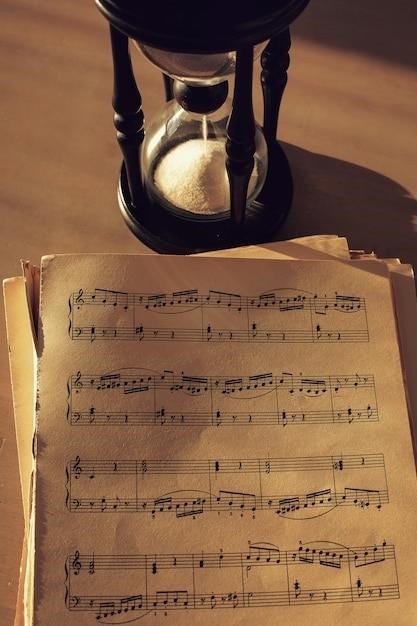Beethoven’s Moonlight Sonata⁚ A Comprehensive Guide
The “Moonlight Sonata,” formally known as Piano Sonata No․ 14 in C-sharp minor, Op․ 27 No․ 2, is a renowned piano composition by Ludwig van Beethoven․ Completed in 1801 and dedicated to his pupil, Countess Giulietta Guicciardi, it is one of his most popular works․ This sonata is a masterpiece that continues to captivate audiences and inspire musicians worldwide․ This guide will delve into its history, the origin of its nickname, its structure, and more․
Introduction
The Moonlight Sonata, a captivating and deeply expressive piano composition by Ludwig van Beethoven, has captivated audiences for centuries․ This timeless masterpiece, formally known as Piano Sonata No․ 14 in C-sharp minor, Op․ 27 No․ 2, is widely regarded as one of Beethoven’s most popular and enduring works․ Its haunting melodies, dramatic shifts in dynamics, and evocative harmonies continue to resonate with musicians and listeners alike․ From its humble beginnings in the early 19th century to its enduring presence in concert halls and music classrooms worldwide, the Moonlight Sonata has become a cornerstone of the classical piano repertoire․ It stands as a testament to Beethoven’s genius and the enduring power of music to touch the human soul․
The History and Origin of the Moonlight Sonata
Beethoven composed the Moonlight Sonata in 1801, a period marked by significant artistic and personal challenges․ The sonata was completed a year before its dedication in 1802 to Countess Giulietta Guicciardi, a young woman with whom Beethoven is believed to have been in love․ Although Beethoven did not explicitly name the piece “Moonlight Sonata,” this evocative moniker emerged later, after his death, in 1832․ The first movement, particularly, was described by German poet Ludwig Rellstab as resembling moonlight shimmering on Lake Lucerne, a comparison that resonated with the public and ultimately cemented the name․ The Moonlight Sonata stands as a testament to Beethoven’s creative brilliance during a transformative period in his life, a time when he was grappling with the onset of deafness and seeking new musical expressions․
The Nickname “Moonlight Sonata”
The “Moonlight Sonata” wasn’t actually named by Beethoven himself․ The nickname, which is now synonymous with the piece, originated in 1832, eight years after Beethoven’s death․ It was German poet Ludwig Rellstab who penned a description of the first movement, comparing it to the ethereal glow of moonlight reflecting on Lake Lucerne․ This poetic imagery captured the imagination of the public, and the moniker “Moonlight Sonata” became widely adopted․ While Rellstab’s interpretation is often cited, it’s important to note that Beethoven never explicitly intended for the piece to be associated with moonlight․ The sonata itself is a complex and emotionally charged composition, offering a rich tapestry of musical ideas that transcend any single literary interpretation․ However, Rellstab’s evocative description has undoubtedly contributed to the enduring popularity and mystique surrounding this iconic work․

The Movements of the Sonata
Beethoven’s “Moonlight Sonata” is a three-movement sonata, each movement showcasing a distinct character and mood․ The first movement, marked “Adagio sostenuto,” is the one most often associated with the “Moonlight” nickname, due to its slow, ethereal, and melancholic nature․ This movement is characterized by its delicate arpeggiated figures in the left hand, creating a sense of shimmering light, while the right hand plays a more lyrical melody․ The second movement, “Allegretto,” is a charming and contrasting scherzo, marked by its quick tempo and playful character․ It features a contrasting trio section in a more lyrical and reflective style․ The third movement, “Presto agitato,” is a dramatic and virtuosic finale․ It is characterized by its rapid tempo, complex rhythms, and intense emotional expression․ This final movement brings the sonata to a powerful and energetic conclusion․

Adagio Sostenuto
The first movement, “Adagio sostenuto,” is the most famous and recognizable part of the “Moonlight Sonata․” This movement is written in C-sharp minor, a key known for its dramatic and melancholic qualities․ It begins with a haunting melody played in the right hand, while the left hand plays a slow, sustained, and repeated arpeggiated figure․ This arpeggiated pattern, often described as resembling the shimmering of moonlight on a lake, creates a sense of quiet contemplation and introspective emotion․ The movement is characterized by its slow tempo, lyrical melody, and expressive harmonies, creating a sense of mystery, longing, and even a touch of sadness․ It’s this distinctive and evocative opening that has made the “Moonlight Sonata” one of the most iconic and enduring pieces in the piano repertoire․
Allegretto
The second movement, “Allegretto,” is in a contrasting key of D-flat major and features a lighter, more cheerful character․ The tempo is faster than the first movement, and the music is more playful and lyrical․ The movement is in a rondo form, with a recurring theme that is interrupted by contrasting episodes․ The middle section, marked “Trio,” is in F major and features a more intimate and delicate character․ The movement as a whole is a refreshing contrast to the dark and introspective first movement, offering a sense of hope and optimism․ The “Allegretto” movement is a delightful and charming interlude before the final, dramatic climax of the “Presto Agitato” movement․
Presto Agitato
The final movement, “Presto Agitato,” returns to the original key of C-sharp minor and is a whirlwind of energy and passion․ The tempo is extremely fast, and the music is highly dramatic and virtuosic․ The movement is in sonata form, with a clear exposition, development, and recapitulation․ The “Presto Agitato” movement is a tour de force of technical brilliance and emotional intensity․ It demands a high level of skill and stamina from the performer, and it is often regarded as one of the most challenging movements in the entire piano repertoire․ The “Presto Agitato” movement brings the “Moonlight Sonata” to a powerful and unforgettable conclusion․
The Dedication and Inspiration
The “Moonlight Sonata” was dedicated to Countess Giulietta Guicciardi, a young noblewoman who was a pupil of Beethoven․ The exact nature of their relationship is debated, with some believing it to be romantic, while others suggest it was purely professional․ The sonata was composed during a turbulent period in Beethoven’s life․ He was beginning to experience the onset of deafness, a profound and isolating condition that would ultimately shape his creative output․ The “Moonlight Sonata” is often seen as reflecting Beethoven’s emotional turmoil and the challenges he was facing․ However, it is important to note that Beethoven himself never explicitly linked the sonata to any specific person or event․
The Significance of the Moonlight Sonata
The “Moonlight Sonata” holds a significant place in the piano repertoire, being one of the most beloved and frequently performed piano sonatas in the world․ It is widely recognized for its dramatic contrast of moods, its use of contrasting dynamics, and its evocative musical language․ The sonata’s first movement, with its haunting and ethereal opening theme, has become particularly iconic․ The work’s popularity can be attributed to several factors․ Its accessibility, despite its technical demands, appeals to a broad audience, from casual listeners to seasoned pianists․ It has also been featured in countless films, television shows, and other media, further solidifying its cultural impact․ The “Moonlight Sonata” continues to inspire musicians, composers, and audiences alike, serving as a testament to Beethoven’s genius and the enduring power of music․
Finding and Downloading the PDF Sheet Music
Obtaining a PDF copy of the “Moonlight Sonata” sheet music is readily achievable․ Numerous online resources offer free downloadable versions․ Websites like IMSLP (International Music Score Library Project) provide a comprehensive library of public domain music scores, including Beethoven’s works․ These sites often offer various editions and arrangements, allowing you to choose the version that best suits your skill level and preferences․ Additionally, dedicated sheet music platforms like Sheet Music Plus and Musicnotes offer both free and paid digital downloads of the “Moonlight Sonata․” These platforms often include interactive features such as annotations, performance notes, and the ability to adjust the score’s size and layout․ With a quick search online, you can easily find and download the PDF sheet music for Beethoven’s “Moonlight Sonata” and embark on your musical journey․
Popular Arrangements and Editions
The “Moonlight Sonata” has been the subject of numerous arrangements and editions, catering to various musical tastes and skill levels․ While the original piano solo version remains the most popular, there are also arrangements for other instruments, such as the guitar and flute․ These adaptations allow musicians with diverse musical backgrounds to experience the beauty of the sonata․ For pianists, several editions offer different levels of difficulty, ranging from simplified versions for beginners to more challenging scores for advanced players․ Some editions even incorporate performance notes and annotations, providing insights into Beethoven’s intentions and offering guidance on interpretation and expression․ Choosing the right arrangement or edition can enhance your musical journey and allow you to connect with the “Moonlight Sonata” in a meaningful way․
Tips for Learning and Performing the Moonlight Sonata
Embarking on the journey of learning and performing Beethoven’s “Moonlight Sonata” can be a rewarding experience․ Here are some tips to guide you⁚
- Start with a solid foundation⁚ Ensure you have a good grasp of basic piano technique and music theory․ Practice scales, arpeggios, and chord progressions to build strength and dexterity․
- Choose an appropriate edition⁚ Select an edition that matches your skill level and preferences․ There are simplified versions for beginners and more challenging scores for advanced players․
- Focus on dynamics and phrasing⁚ The “Moonlight Sonata” is known for its dramatic contrasts in volume and expressive phrasing․ Pay close attention to the dynamic markings and strive to create a nuanced performance that captures the emotional depth of the music․
- Practice regularly and consistently⁚ Set aside dedicated time for practice and stick to a consistent schedule․ Regular practice will help you develop muscle memory and improve your overall performance․
- Seek guidance from a teacher⁚ Consider working with a qualified piano teacher who can provide personalized instruction and feedback․ A teacher can help you identify areas for improvement and refine your technique and interpretation․
Beethoven’s “Moonlight Sonata” stands as a testament to the composer’s genius and enduring legacy․ Its evocative melodies, dramatic contrasts, and profound emotional depth have captivated audiences for centuries․ Whether you are a seasoned pianist or a curious beginner, the “Moonlight Sonata” offers a unique and enriching musical journey․ By understanding its history, appreciating its structure, and following the tips outlined in this guide, you can unlock the secrets of this iconic composition and discover the beauty and power that lies within its notes․ The “Moonlight Sonata” continues to inspire and resonate with listeners around the world, proving that the power of music transcends time and language․
Leave a Reply
You must be logged in to post a comment.